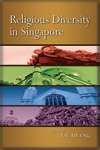
IPS Forum on Religious Diversity in Singapore
Part 2 of 3: Part 1; Part 2; Part 3
Session II: Interfaith Issues and Interaction
Religious Switching and Knowledge among Adolescents in Singapore
Assoc Prof Phyllis Chew Ghim-Lian
Department of English Language and Literaure, NIE
The first part of the presentation was on Religious Switching.
2,779 students from 6 schools: 4 neighborhood, 2 aided, were surveyed. 5.7% of them were religious switchers - they had different religions from their parents. 82% believed in some sort of deity. The sample had more Christians but fewer Buddhists than the last Census; the proportion of Muslims was the same.
Most (60%) who switched religions switched to Christianity or free-thought (19%). 6% switched to Soka, 3% to Wicca [Ed: Many people in the audience didn't know what 'Wicca' was] and 1% to Buddhism. The unexpected presence of Wicca was because the study was done in 2004-5, at the height of the Harry Potter craze, and all of the Wiccans came from one neighborhood school, so it was probably a peer influence thing.
There were 3 types of switchers: Buddhists/Taoists, Christians and Freethinkers. Switching occured from Taoism/Buddhism/Hinduism to Christianity, or Taoism to Buddhism. Christians tended to switch to free-thought, and free-thinkers to Christianity or Buddhism. Muslims did not switch.
51% of switchers used English primarily at home, 5% Mandarin and 10% were code-switchers.
The next part of the presentation was on Religious Knowledge.
Students were asked how much they knew about the 9 religions represented on the IRO (Inter-Religious Organisation) at the time of the study (it's now 10). Since the survey was done during their CME (Civics and Moral Education) class, they tried their best.
60% gave general comments on the religions (superficial comments from daily observation), 13% gave specific comments (more detailed comments) and 31% had no comment (I assume the first two categories were not mutually exclusive). Where specific comments were given, they were given only about the respondent's own religion, and they were in the form of doctrinal repetitions (e.g. Christ came down to earth for our sins) rather than neutral descriptions.
93% of respondents said nothing at all about Judaism, Zoroastrianism or the Bahai'i faith. The rest made wild guessed, that Zoroastrianism was about the sign of Zorro, Jews prayed to the sun and the stars and Bahai'i had something to do with the Dalai Lama.
Respondents described themselves in superficial ways, saying materialism and social activity made them happy.
Respondents said that religious tolerance meant "not talking about it", but they were very aware of the need to show respect toward race and religion.
24% of the respondents engaged in stereotyping. Hinduism was associated with "skewers" and Christianity with perpetual requests for money. Most stereotyping was directed towards new or minority faiths, for example City Harvest and Jehovah's Witnesses (who, they said, sacrificed people).
Yet, respondents knew about inter-denominational rivalry.
92% of respondents were not interested in knowing more about other religions. If they were, it was because of relationships (the religions of their partners). [Ed: From this point on, the speaker was talking quite quickly and I don't have the book with me right now, so the last part here may be wrong]
Relationship, happy feelings, purpose (idealism) and push factors caused people to switch religions.
46% learnt about their new religion from friends, and 7% from teachers and school counsellors [Ed: This is not supposed to happen]. Switching happened fast, with 1/3 happening within a month.
50% of switchers faced opposition from their parents, who said they were wasting time on non-studies-related activities, but they eventually relented.
Building Bridges between Christians and Muslims
Ms See Guat Kwee
This presentation was literally a sob story.
The presenter described a trip to the Holy Land with someone else. When she was with a Jewish guide, the places she went to were totally different from those the Palestinian guide brought her to.
She asked why there was no peace and harmony in the Holy Land, and was told to go to refugee camps, and there things went topsy turvey. She got hospitality, was welcomed and received stories and food.
A Muslim asked why God put all 3 religions on the same land, with so much suffering, and said maybe he wanted them to learn to live together.
She and the other girl did some research on Singapore, and discovered the IRO. In Israel there were >70 organisations involved in inter-religious work.
In the Holy Land, the presenter engaged in therapy sessions, and then brought the ICCI (Interreligious Coordinating Council in Israel) to Singapore in 2001.
One Taoist she spoke to was very upset because Christian evangelists, though they saw the Taoist altar in his home and knew they were Taoists, persisted in proselytising. The presenter and her companion were bewildered because they had good intentions.
After 9/11, there were more of the usual interfaith sessions between Christians, Muslims and Jews [Ed: Other faiths did not seem to be involved]. At the Hartford Seminary, students from the Abrahamic Faiths engaged in inter-religious interaction. Inter-religious interaction is not just doctrine but also about historical events and baggage.
After her journey, she came out a better Christian with stronger faith [Ed: ???].
The following picture published in National Geographic was then shown:

The expectation was that the husky would attack the polar bear, but what actually happened was:

The two played together
The moral of this, we were told, was that "If you want to see the good, you see the good. If you want to see the bad, you see the bad."
Q&A
Q: Singaporeans are critical of themselves too much. My company deals with cross-cultural communication and I've worked in 18 countries, and in my experience, there is no better example than Singapore for religious tolerance and understanding. We should look at what Singapore is doing right. Religious tolerance is built into the school curriculum. Singapore can teach the world about tolerance.
A: The best person to answer this question is Tommy Koh, but he has left the room. *asks Ambassador Ong to say a few words*
A: We are too hard on ourselves sometimes, but we must examine the issues.
The system is inadequate - look at the students' ideas.
The problem with the approach to religion in the media - he and Tommy Koh had no idea what Wicca was.
A: It is fortunate because of the Founding Fathers, some were agnostic and some were free-thinkers. Rajaratnam was agnostic. I don't know what religion LKY is. So this led to a flat level playing field. We could become race-, colour- and religion-blind, leading to the equilibrium we have now.
Q from me: I said that I was very depressed that the students surveyed thought racial harmony involved "not talking about it", but observed that this attitude carried over into adult life
I then summarised a case I'd seen earlier where one comment about a stupid Malay brought on idiots crowing that they'd reported him to the authorities.
I then noted that this hypersensitivity about racial/religious issues in Singapore was unhealthy and impeding deeper tolerance and understanding.
[Ed: For some reason everyone was amused when, at the start, I said I was unaffiliated. I think usually unaffiliated people have better things to do than attend conferences like this.]
A: A poem from the second speaker about a square meeting a circle, the square not being able to enter the circle and only the circle being able to let the square in, and that we're all circles with beauty and song [Ed: ????????????????????????????????????????????????????????????????????????????????????]
Q: Singapore is a good model. What we've done right:
1) HDB racial quotas to force the races to mix
2) Saying we cannot take racial/religious harmony for granted
3) Having strict legislative boundaries about what you can say and cannot say
4) Maintaining common ground, e.g. National ideology and a common language (English)
A: The Singapore government had this belief before the phrase came into common usage: Unity In Diversity.
[Ed: "E pluribus unum" ("Out of Many, One") has been a motto on the Great Seal of the United States since 1782, 37 years before Singapore was founded as a British Colony, 177 years before Singapore gained Self-Government and 183 years before Singapore became independent.
The phrase comes from Virgil's (of Aeneid fame) poem, Moretum (a poem about making cheese and garlic spread).]
A: When we let people say anything on the subject, wounds come out.
At the seminary, a Jewish girl looked fearfully at Christians because in the 50s, she was stoned and called "Christ-killer" by Christian children.
We are grateful to the government and history, but we cannot have the government do everything. Civil society and the religious communities need to do things themselves.
If the government says 'make friends', you get superficial results. You need deep friendships, and difficult issues discussed, e.g. the role of Buddha and Christ in the Koran.
Q: As the first IRCC (Inter-Racial Confidence Circles) Chairman, I say the government is doing a bottoms-up job with the IRCC, and community engagement programs. So we have bonds between circles and squares.
Personal note:
Not only do Singapore teens know nothing about other people's religions (and next to nothing about their own), they don't want to know more about them, and they are too scared to say anything about religion in general, lest it, they are told, result in racial riots.
Die lah.


